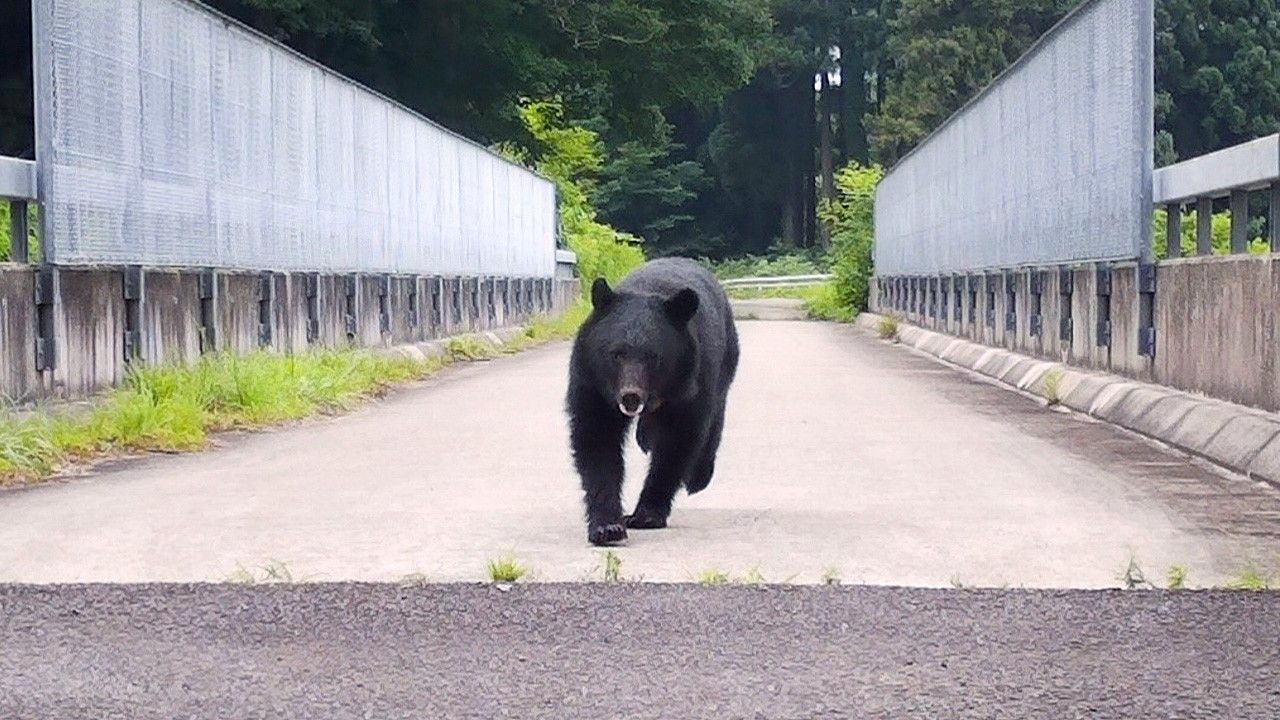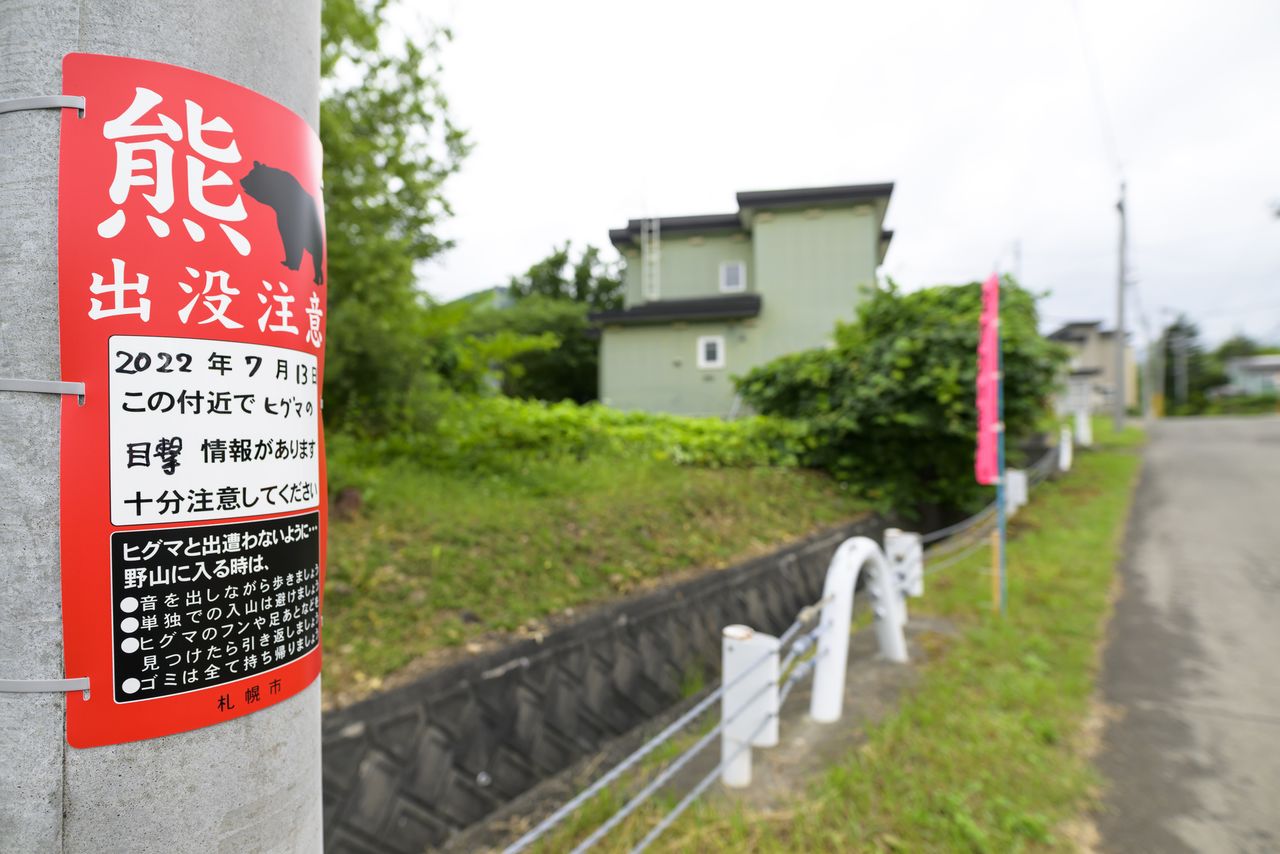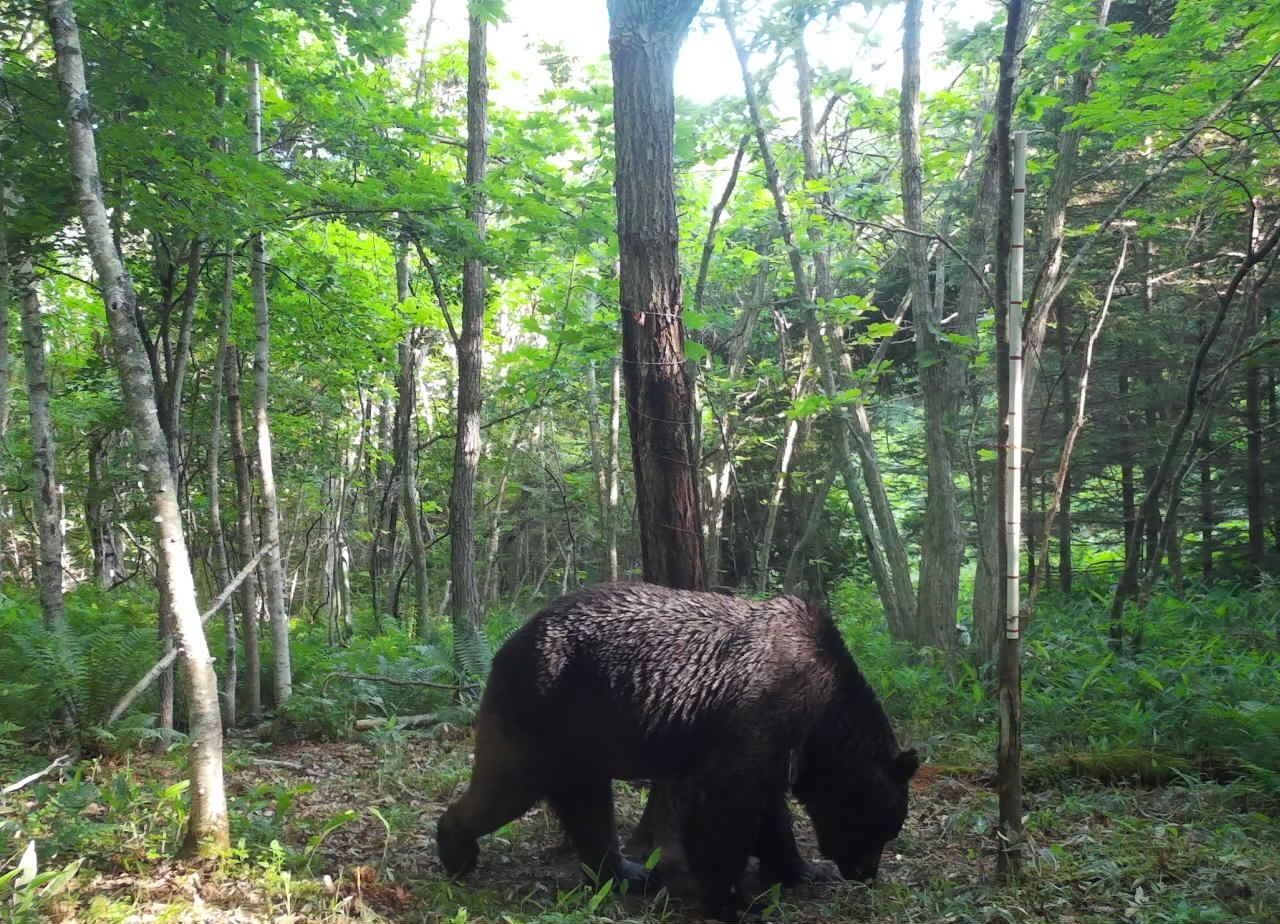
Bears in Japan: Living with Wild Neighbors
Society Culture Lifestyle Environment- English
- 日本語
- 简体字
- 繁體字
- Français
- Español
- العربية
- Русский
Acorn Shortage Sparks Increased Attacks
Of the eight species of bear in the world, two live naturally in Japan: the brown bear, found in Hokkaidō, and the Asian black bear, which inhabits northern Honshū and (in small numbers) Shikoku.
Close relatives of the North American grizzlies, the brown bears of Hokkaidō are among the largest bear subspecies, with males often reaching up to 2 meters from nose to tail. Black bears are somewhat smaller, having an average size of around 1.2 meters. Although the black bear is extinct in Kyūshū, and on the brink of extinction in Shikoku, the total number of bears nationwide has been increasing in recent decades.
“Viewed in the long term, wild bears have been steadily encroaching closer to areas of human habitation,” says Satō Yoshikazu, a bear researcher at Hokkaidō’s Rakunō Gakuen University. “Since 2000, there have been numerous incidents of bears entering urban areas close to human habitations. Acorns and other nuts form an important part of the bears’ diet in the autumn months, and availability of these foods tends to follow a rough cycle of good years and bad. Sometimes, there’s a poor crop of multiple species of acorns and other tree nuts in the same year. When this happens, bears are more likely to stray into villages and towns in search of food. This year, there were more of these incidents than ever before.”
According to preliminary figures released by the Ministry of the Environment, from April 2023 through the end of November, there were 212 attacks by bears on people in Japan, including six fatalities. This was the highest number of attacks since the ministry started to compile figures in 2006.
“In the past, spikes in the number of bear sightings in populated areas have tended to happen at slightly different times in Hokkaidō and Honshū. This year, both regions have been affected at the same time, which is unusual. Unless proper measures are taken to address the issue now, however, it’s quite likely that we will see a similar spate of attacks in a few years’ time,” notes Satō.
The Battle Against the Brown Bear
Japan is not the only country that confronts the issue of “urban bears”—animals that live in forests close to towns and make forays into human settlements when food is scarce.
“American black bears, for example—similar to the species we have in Honshū—have been entering human settlements to feed on garbage and have even been spotted in swimming pools,” explains Satō. “The closest cousin to Hokkaidō’s Ussuri brown bear is the North American brown bear, or grizzly. In previous decades, there were active campaigns to cull this species, which reduced numbers drastically. Today, the main population south of Canada is in Yellowstone National Park and other protected locations. They don’t live close to urban areas. Numbers are much lower in Europe. In Hokkaidō, you have a situation in which brown bears live adjacent to Sapporo, a city of 2 million people. Japan is probably the only country in the world where bears exist so close to a major city.”
Hokkaidō has a long history of conflicts between bears and people, dating back at least to the start of major Japanese settlement and development on the island in the second half of the nineteenth century. One shocking spate of attacks took place at Sankebetsu in the northern part of the island in December 1915, when a brown bear entered two houses, killing seven people, including children and a pregnant woman, and injuring three others over the course of three days. There have been several fictionalizations of this incident, notably Yoshimura Akira’s novel Kuma arashi (Bear Storm), which became a bestseller in 1977 and was later adapted for television. Partly as a result of this notoriety, the brown bear became an object of fear and loathing, widely viewed as an implacable enemy that needed to be wiped out.
As the human population grew in the decades after World War II, increased demand for housing saw wide areas of Hokkaidō’s forests felled for timber. A campaign called the Spring Bear Extermination System started in 1966 with the use of traps and guns to kill off bears as they emerged from hibernation.
From Extermination to Conservation
Numbers of brown bears and many other wild species fell drastically during the 1970s and 1980s. This began to change in the 1990s, as ecological movements around the world began to encourage tolerance and coexistence with nature. Japan ratified treaties on biodiversity and switched to a policy of conserving the nation’s wildlife and the natural environment.
Says Satō: “For a long time, the brown bear was regarded as a dangerous pest, and there were no restrictions on the number of bears that could be culled. This devastated the population and also reduced the bears’ range across Hokkaidō. The situation began to improve in 1990, when the spring extermination program was scrapped and the government switched from culling the bears to a policy of conservation. Numbers started to recover, and this led to an increase in incidents of bears entering farmland and damaging crops from the second half of the 1990s.”
Increasing numbers of Yezo deer are also having an impact on brown bears.
“The image people have is of bears by a river, feeding on salmon. In fact, only a small proportion of Hokkaidō’s bears live like this, in the Shiretoko Peninsula and other remote areas. And even these populations have been affected by a drastic decline in the numbers of salmon and trout returning to spawn in recent years. As a result, bears have turned to predating on Ezo deer.”
Deer are rivals for the herbaceous plants that are one of bears’ favorite foods. In recent years, bears have increasingly taken to predating on deer—often feeding on carcasses culled close to farmland, as well as newborns and vulnerable young fawns.
“I suspect black bears in Honshū probably prey on deer too. In years like this, when there’s a poor crop of acorns, it’s highly likely that wild boars will get to the acorns first and polish off most of the limited supply before the bears can feed.”

A poster warns of a recent bear sighting in Sapporo, Hokkaidō. (© Pixta)
The national government’s biodiversity strategy is another factor behind the increasing presence of bears in urban areas since 2000. Local governments in towns and cities around the country have been steadily planting trees and plants to greenify areas along major roads and rivers, creating a direct link between woodland and the streets of built-up areas. One unintended consequence is that wild animals have started to appear more frequently in urban areas. In Sapporo, there have been cases of brown bears wandering as far as the residential neighborhoods of the city over the past decade or so.
“In the mountains,” Satō says, “bears run away as soon as they see people. But bears that were born close to human settlements grow up hearing the noise of cars and are quite habituated to the presence of people. They have no experience of being chased by hunters, and no fear of human beings.”
The Effect of a Declining Human Population
As in many predominately rural areas of Japan, the population of Hokkaidō is falling and increasingly elderly, notes Satō. “Over the past half century or so, the number of farming families has dropped to around a sixth of what it used to be. Since the total area of farmland has hardly changed, this means the average family is cultivating an area around six times larger than would have been the case fifty years ago. This has gone hand-in-hand with massive mechanization of the farming process.”
Automation of farming created the ideal conditions for bears to access crops, since there were no longer large numbers of farm workers to keep them away. In dairy-farming areas, the national government provided subsidies to make farmers more self-sufficient in animal feed, and this led to a dramatic increase in the acreage of land under cultivation for dent corn. Together with beets and sweetcorn, these crops represent a tempting feast for brown bears, conveniently laid out in easy-to-access fields ripe for the picking.
“Bears’ appetite peaks during the months from late August until they go into hibernation in December. From spring until the end of summer, plant foods make up the bulk of their diet, replaced by acorns and fruits in the autumn. August and September represent a transition period between these two phases. During these months, there is less food available for bears in the mountains. But in agricultural areas, there is an abundance of corn, which ripens for harvest at just the same time of year.
“The problem we’re seeing with bear attacks in recent years is closely linked to the issue of Japan’s aging, graying population,” Satō says. “This decline in the human population of farming villages and mountain settlements represents a relative weakening of human influence in the borderlands where the human and natural worlds intersect.”
The problem, he explains, is that national policy frameworks haven’t changed to reflect this new reality. “We’re still relying on policies from a time when humans were relatively stronger, in the sense that we could subdue and drive back wild animals in these areas by simple force of numbers. In recent years, policymakers have started to come up with new mechanisms for maintaining our current levels of social prosperity with a smaller population—initiatives like smart cities, compact cities, smart farming, and so on. But none of these policies takes into consideration the bears and other wild animals that have regained their strength relative to human settlements, and our response has fallen behind the curve. We’re left playing catch-up.”
The Need for Trained Specialists
Satō worries most that a groundswell of public opinion against the idea of even trying to coexist with bears could lead to haphazard policies.
“Since bears started to expand their range about a decade ago, there has been a debate about whether it is safe to allow the numbers to continue to grow. As academic researchers, our suggestion has been that we should train specialists and send them into these areas to monitor and manage the population of bears, deer, boars, and other wild animals. But almost nothing has been done to implement this idea.”
Satō says that a few pioneering authorities in some areas have taken steps to build local communities that are more resilient to bears and other wildlife. In Shimane Prefecture, for example, the prefectural forestry department oversees an integrated wildlife management program that incorporates conservation policies alongside policies to mitigate damage caused to human livelihoods and property by wildlife. Relevant organizations monitor local wildlife and carry out population surveys and other research. These areas have made substantial progress in appointing wildlife specialists to towns and cities, who play an important coordinating role between residents and local governments, and between local municipalities and the prefectural government.
“But these are the exceptions. Most of the time, prefectures leave everything to the local towns, and the towns leave everything to local hunting associations. But these are groups of recreational hunters. For most members, it’s a hobby: they don’t have any training or experience in conservation or wildlife management. Although these groups do their best to address the bear problem out of a sense of responsibility to their communities, age is an issue and there is a shortage of hunters in some areas.
“So one thing we need is a mechanism that will make it easier for local governments to train and employ hunters. There’s no reason to think that the widespread damage we have seen from bear attacks this year was a one-off. Unless local governments develop proper policies, including training and deploying specialist personnel, and include funding to cover these measures in their budgets, sooner or later the same thing will happen again.”
Making the Response More Visible
Until recently, a brown bear identified as OSO18 terrorized residents in Shibecha, Akkeshi, and other small towns in Hokkaidō, where it was responsible for attacks on 66 cattle over a period of four years from 2019. But when a bear killed by hunters in July this year was confirmed to be OSO18, local authorities received a mass of complaints asking why it was necessary to destroy it. In Akita Prefecture too, there have been complaints from conservationists who object to the policy of killing bears in the aftermath of attacks on people or livestock.

Bear OSO18, which was culled in July 2023 after a spate of attacks on cattle in Hokkaidō. (Courtesy Shibecha municipal government; © Jiji)
“I think we need a system of crisis response that people can understand regardless of their position on the issue. If you set up electric fences to keep bears away, and make sure that no food or other garbage that might attract them is left outside, and even after all these steps have been taken, a bear intrudes into areas where people live and work . . . probably most people would be ready to accept the logic of destroying the animal in those circumstances.”
Satō says he would like to see specialists assigned to areas with large bear populations to monitor the population and collect data on a daily basis. Also, he notes, in drawing up concrete measures to address the problem, policies must be coordinated with local opinion, taking into account the views of people impacted by the attacks as well as those who are not directly affected.
“In many cases where bears have been responsible for damage to human livelihoods or livestock, it is possible to identify an individual culprit. I think more could be done to make the response visible. We should make it easier for people to see which particular bear is responsible for what damage, which bears have been destroyed, and how the situation has improved as a result.”
Learning from the Ainu View
For the Ainu, the indigenous people of Hokkaidō, the bear was not simply an enemy or an animal to be hunted. Traditional Ainu culture understood the brown bear as a pair of mutually opposed spirits. As an important source of meat and fur, the brown bear was revered as the kimun kamuy (god of the mountains). People would perform a sacrificial ceremony of thanksgiving to send off the spirit of the bear to the realm of the gods and to pray for its return.
But brown bears that damaged people or livestock were regarded as wen-kamuy (evil spirits). The Ainu people would unflinchingly stand up to this kind of bear and take whatever steps were necessary to trap and kill them. But a strict taboo prohibited eating the meat from this kind of “evil” bear.
“In the case of ‘urban bears,’ culling a specific wen-kamuy that has been responsible for attacks often reduces the number of unwanted encounters in other places some distance from the original incident. Rather than randomly reducing the total numbers of bears when they increase beyond a certain level, moving quickly to eradicate an individual wen-kamuy both protects the community and also helps to maintain the population of bears in the long run. This is a lesson we should remember.”
Satō first encountered wild bears in 1991, when information on sightings was much harder to come by than it is now. He took part in an observation survey as a member of a research group at Hokkaidō University. He remembers seeing a mother bear and her cubs feeding in a field by a river, their fur glinting golden in the evening sunlight and ruffled by a gentle breeze. He has never forgotten the emotional rush of this first glimpse of bears in the wild.
“In this country, we are lucky to have a healthy population of bears living natural lives in the forests of Hokkaidō and northern Honshū. I want to preserve that for our children and grandchildren. It’s vital that we protect these local populations. My hope is that people will treasure and enjoy the rich natural environment that survives and learn more about bears and their ecology—and that eventually we will develop a new way of coexisting alongside nature and wild animals.”
(Originally written in Japanese by Kimie Itakura of Nippon.com. Banner photo: A black bear captured on a traffic camera in Kazuno, Akita Prefecture, in July 2023. Photo courtesy Akita Prefecture Nature Conservation Department; © Jiji.)
